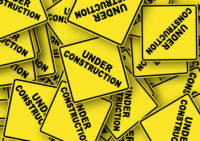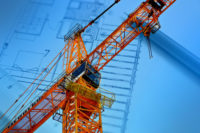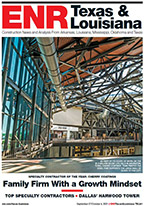Nonbuilding Construction
Nonbuilding construction, at $148.7 billion (annual rate), decreased 9% in October. Most of the decline was due to a 67% plunge for electric utilities after unusually strong activity in September. The latest month did include the start of one major electric utility project, an $850-million natural gas-fired power plant in Ohio, but this was in comparison to several projects of even larger scale entered as September starts. The public works group as a whole increased 8% in October, showing further progress after a 25% increase in September.
Highway and bridge construction in October climbed 27%, supported by the $598-million Northwest Corridor project in Atlanta. Through the first 10 months of 2014, the top five states for highway and bridge construction starts were Texas, California, Pennsylvania, Illinois and Ohio. States ranked six through 10 were Florida, New York, Georgia, North Carolina and New Jersey.
Sewer and waste disposal projects soared 80% in October, boosted by the start of an $800-million carbon-capture facility in Texas while water supply projects improved 20%.
Public works categories that declined in October were river and harbor development, down 22%; and miscellaneous public works, down 32%. The miscellaneous public works category had been lifted in September by a large light rail project in Los Angeles and a natural gas pipeline in Arizona. Although activity for this category was substantially lower in October, it did include $575 million for the start of renovation work on Wrigley Field in Chicago.
Residential Building
Residential building in October grew 11% to $245.9 billion (annual rate). After sliding 20% in September, multifamily housing had a particularly strong month in October, climbing 40%. There were 11 multifamily projects valued at $100 million or greater that reached groundbreaking in the latest month, with the top three as follows—a $433-million high-rise in New York City, a $272-million high-rise in Brooklyn, N.Y., and a $200-million high-rise in Miami.
Through the first 10 months of 2014, the top five metropolitan areas for multifamily construction starts (in dollars) were New YorkCity, Miami, Washington, D.C., Los Angeles and San Francisco. Metropolitan areas ranked six through 10 were Boston, Dallas-Fort Worth, Philadelphia, Seattle and Houston.
Single-family housing in October was unchanged from its September pace, further extending the essentially flat pattern of activity that’s been present since the end of 2013. In October, weaker single-family construction was reported in the Northeast, down 5%; and the South Central, down 2%; while gains were reported in the West and South Atlantic, each up 2%; and the Midwest, up 3%.
“Despite very low mortgage rates, with the 30-year fixed rate hovering around 4.0%, it still remains difficult for first-time homebuyers to get a mortgage,” Murray said. “On a hopeful note, the latest survey of bank lending officers by the Federal Reserve did show some easing of mortgage lending standards during this year’s third quarter, maintaining the trend towards slight easing that began in the spring.”
The 5% increase for total construction starts on an unadjusted basis during the first 10 months of 2014 was the result of mixed behavior by the three main construction sectors. Nonresidential building advanced 14% year-to-date, with each of its three components registering growth—commercial building, up 14%; manufacturing building, up 52%; and institutional building, up 5%.
Residential building improved 7% year-to-date, with single family housing up only 2% while multifamily housing jumped 25%. Nonbuilding construction fell 8% year-to-date, with public works down 7% and electric utilities down 14%.
By geography, total construction starts during the January-October period of 2014 showed growth in all five regions—the South Central, up 13%; the South Atlantic and the West, each up 4%; and the Northeast and the Midwest, each up 1%.




Post a comment to this article
Report Abusive Comment